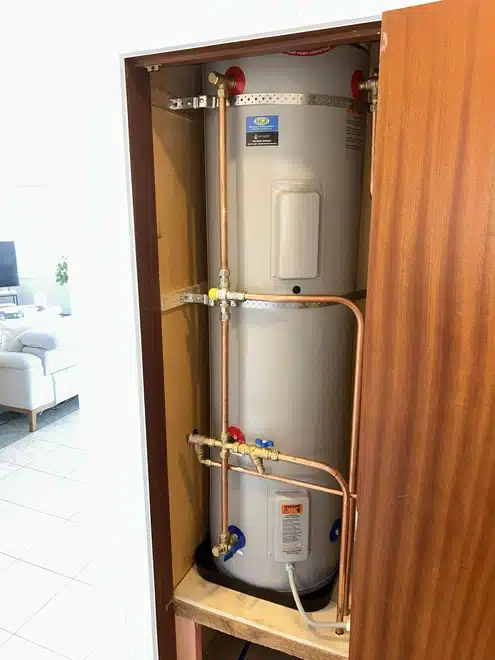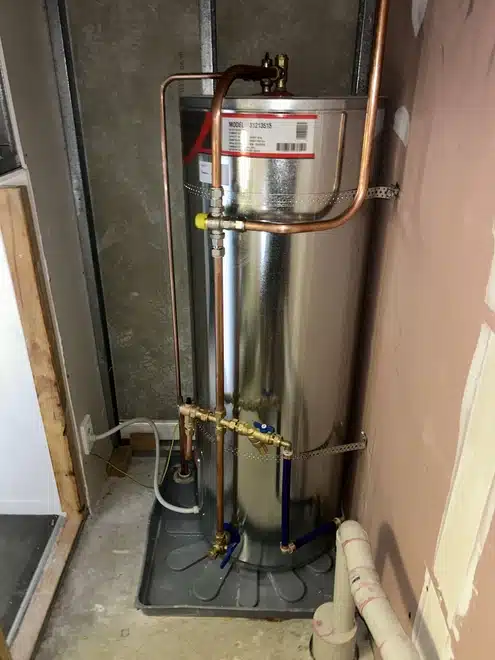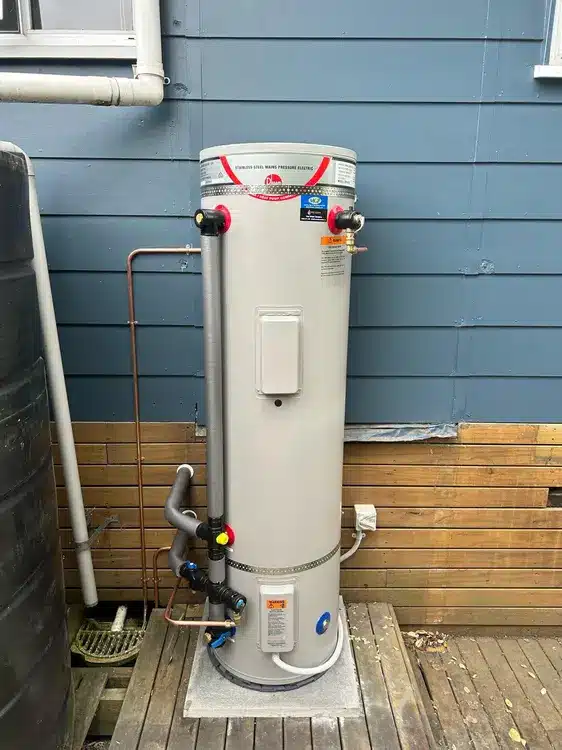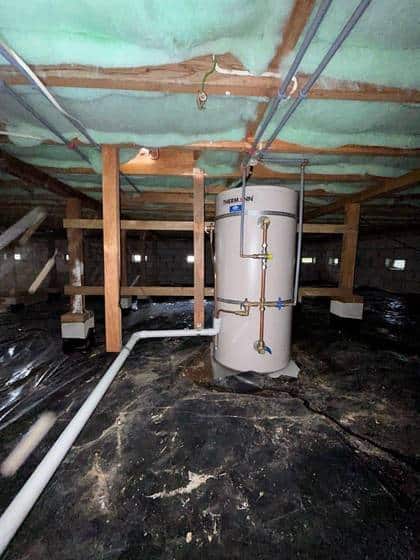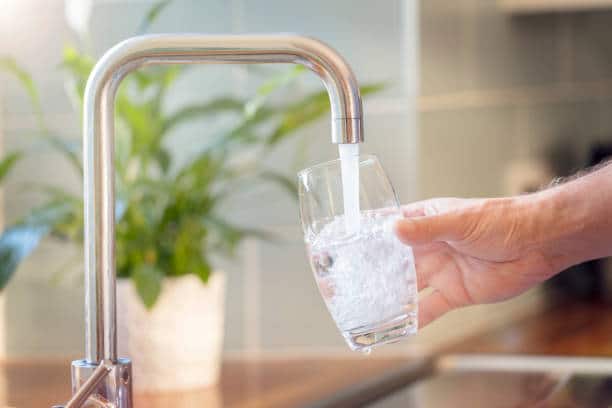How Does a Hot Water Cylinder Work?
A hot water cylinder, also called a hot water cylinder, stores heated water and delivers it to taps, showers, and appliances when needed. The cylinder is filled with cold water from the mains (or a separate cold-water cylinder), which is then heated either by an electric element (immersion heater) or an external heat source like a gas boiler or solar panel.
Once heated, the water remains insulated inside the cylinder until used. Some systems are “pressurised” (unvented), giving high-pressure flow to all outlets, while others rely on gravity (vented), typically delivering water at lower pressure.
Types of Hot Water Cylinders
Hot water cylinders come in a few main types, and choosing the right one depends on your home’s size, heating setup, and water usage habits.
1. Direct Hot Water Cylinders
These cylinders heat water internally using an electric immersion heater. They are independent systems and do not require a boiler, making them ideal for homes without gas connections or in areas like Rotorua or Dunedin where electricity is more common.
2. Indirect Hot Water Cylinders
These rely on an external source, typically a gas or oil boiler, to heat the water via a coil that runs through the cylinder. Indirect systems can be more energy-efficient and are suitable for homes with central heating systems.
3. Solar-Ready Cylinders
Designed to integrate with solar thermal panels, these cylinders often have multiple coils, allowing them to be heated by the sun and a boiler or immersion heater as a backup. They’re popular in eco-conscious areas like Nelson and Wellington.
4. Combination Systems
Some modern systems combine features of storage cylinders and on-demand heating to maximise space and efficiency, perfect for compact urban homes in cities like Auckland.
Direct vs. Indirect Hot Water Cylinders
A major decision homeowners face is choosing between direct vs. indirect hot water cylinders. Here’s a breakdown of the differences:
| Feature | Direct Cylinder | Indirect Cylinder |
|---|---|---|
| Heat Source | Immersion heater | External boiler or solar panel |
| Backup Required? | No | Yes, in case boiler fails |
| Installation Cost | Lower | Higher |
| Ideal For | Homes without boilers | Homes with central heating |
| Energy Efficiency | Moderate | Higher (especially with solar) |
Unvented vs. Vented Hot Water Cylinders
Another important distinction is unvented vs. vented hot water cylinders. Each system has its pros and cons, depending on water pressure needs and building infrastructure.
Unvented Hot Water Cylinders:
- Connected directly to mains water
- Provide strong water pressure
- Require safety devices to handle pressure
- Suitable for modern homes in Auckland and Wellington
Vented Hot Water Cylinders:
- Supplied by a cold-water cylinder (usually in the attic)
- Use gravity to feed water to taps
- Simpler design, but with lower pressure
- Often found in older homes in Christchurch or Invercargill
What Size Hot Water Cylinder Do I Need?
Choosing the right size cylinder is critical. Too small, and you run out of hot water. Too large, and you’re wasting energy heating water you don’t use.
Here’s a general sizing guide:
- 1–2 people: 90–120 litres
- 2–3 people: 135–180 litres
- 3–4 people: 180–210 litres
- 4–5+ people: 250–300+ litres
If your household uses multiple bathrooms or showers at the same time, or if you frequently run appliances like dishwashers and washing machines, opt for a slightly larger size. Homes in growing areas like Tauranga or Hamilton often benefit from flexible, family-sized cylinders that can scale with increasing needs.
How To Improve the Performance of Your Hot Water Cylinder
Over time, your hot water cylinder can lose efficiency due to scale build-up, insulation degradation, or thermostat issues. Here are some ways to enhance performance:
1. Add or Upgrade Insulation
Older cylinders may not have modern insulation. Wrapping your cylinder in an insulation jacket can significantly reduce heat loss.
2. Install a Timer
This allows you to heat water only when needed, saving energy. Set your timer to pre-heat water during off-peak hours.
3. Flush the cylinder
Sediment buildup can lower efficiency and lead to damage. Flushing your cylinder annually helps maintain performance.
4. Check the Thermostat
Ensure it’s set to an efficient but safe level, typically between 60°C and 65°C.
5. Upgrade to a Modern Cylinder
If your cylinder is over 10–15 years old, consider replacing it. Newer models are far more energy-efficient and have faster heat recovery rates.
Common Issues with Hot Water Cylinders
Even the best systems can face problems. Here are some typical issues and what they might mean:
1. No Hot Water
- Faulty immersion heater
- Broken thermostat
- Pilot light out (for gas systems)
2. Low Water Pressure
- Common with vented systems
- Could indicate limescale buildup or blocked pipework
3. Leaking Cylinder
- Corrosion inside the cylinder
- Faulty pressure relief valve
- Leaking pipe connections
4. Strange Noises
- Often caused by sediment buildup or overheating
5. Water Too Hot or Too Cold
- Thermostat malfunction
- Incorrect timer settings
10 Frequently Asked Questions
Understanding your hot water cylinder is key to energy efficiency, comfort, and avoiding costly repairs. Whether you’re considering a new system or simply looking to get the most from your current setup, being informed about the types of hot water cylinders, direct vs. indirect hot water cylinders, and what size hot water cylinder you need will help guide the way.
Looking for expert help choosing or installing the best system for your home? Visit What is the best hot water cylinder in NZ? for professional advice and services across New Zealand cities.
Final Thoughts
When it comes to heating water efficiently in New Zealand homes and businesses, understanding the types, sizing, and integration options for hot water cylinders is essential. Whether you’re planning a small apartment upgrade or managing a commercial building’s needs, the right information can save you time, energy, and money.
Looking for top-quality service and support? Trust the team at Hot Water Solutions NZ, they’re your go-to experts for everything from sizing to installation across all NZ cities.


